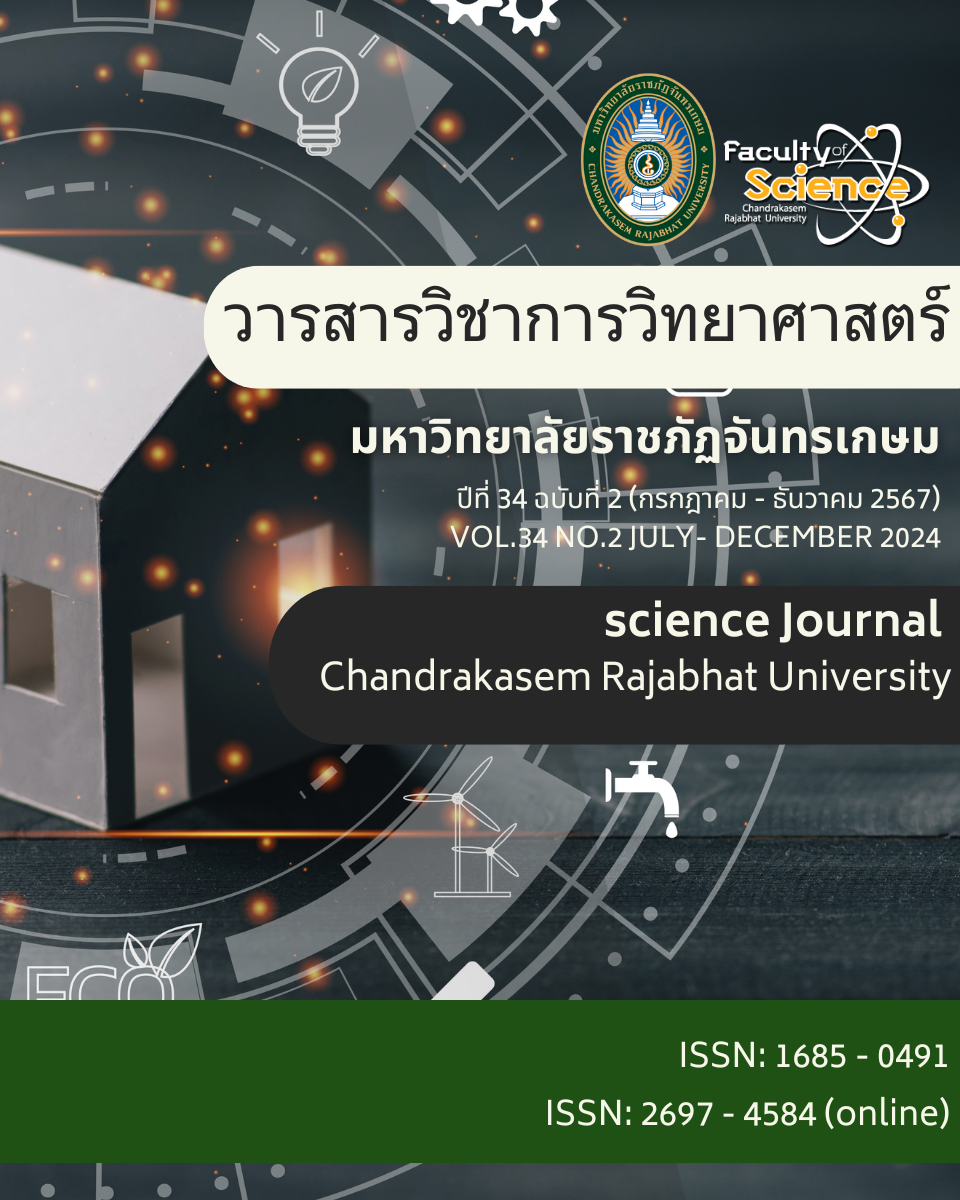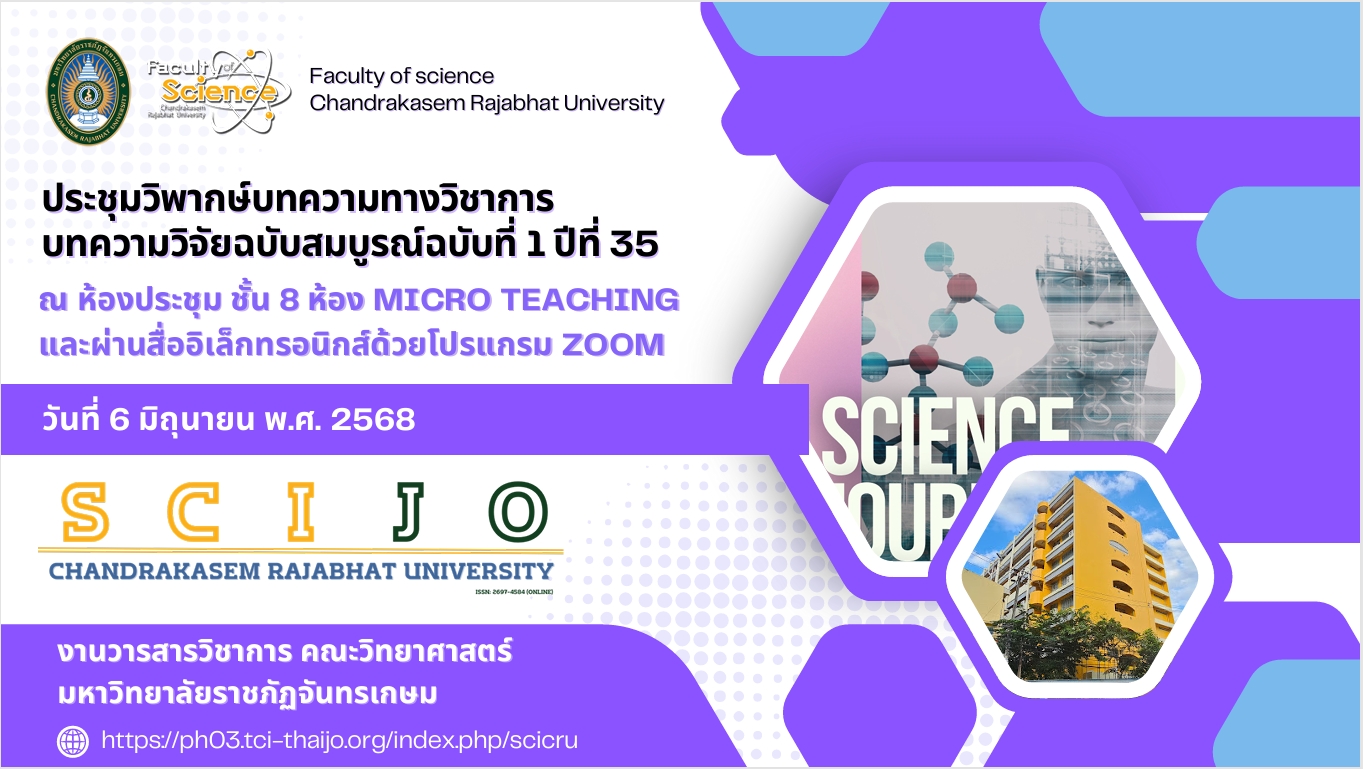Phytochemical and Efficiency of Garden Balsam Leaves (Impatiens balsamina L.) in Inhibiting Aspergillus
Keywords:
Phytochemistry, Garden Balsam, AspergillusAbstract
Collecting samples of Garden balsam from the school botanical garden of Benjamarachanusorn School. The specimen was determination from the forest herbarium office, it agrees with BKF.No.14240, species Impatiens balsamina L. When 100 grams of the Garden balsam fresh leaves was dried, the dry weight was 13.08 grams. When crushed, it looks like a fine powder of 100 microns, he greeny smell of leaves and L*, a* and b* have color values of 47.09, 2.33 and 17.11 respectively. The leaf powder extracted with ethanol was used as solvent, it was found that, the crude extracted had a viscous appearance, L*, a* and b* had color values of 20.43, 1.81 and -1.51 respectively with greeny smell of leaves. The crude extracted yield percentage was 15.53. The phytochemical analysis of crude extracted found cardiac glycosides, saponins, tannins and phenolics but flavonoids and alkaloids were not found. The efficacy of garden balsam leaves in inhibiting Aspergillus. It was found that PDA mixed with 10 and 5 grams of garden balsam leaves. It inhibits A. flavus TISTR 3130 at 32.74% and 28.38%, respectively, inhibits A. niger TISTR 3012 at 18.86% and 12.86% and inhibits A. terreus TISTR 3109 at 20.40% and 15.65%, respectively.
References
ก่องกานดา ชยามฤต และวรดลต์ แจ่มจำรูญ. (2559). คู่มือจำแนกพรรณไม้. สำนักวิจัยการอนุรักษ์ป่าไม้และพันธุ์พืช.
เกศกนิษฐ์ ธรรมคัมภีร์ และเพ็ชรงาม ไชยวานิช. (2563). ความชุก ปัจจัยเสี่ยง และชนิดเชื้อราก่อโรคในผู้ที่มีโรคเชื้อราที่เล็บในผู้ป่วยเบาหวาน โรงพยาบาลมหาวิทยาลัยบูรพา. (รายงานการวิจัย), มหาวิทยาลัยบูรพา. BUUIR. https://buuir.buu.ac.th/handle/1234567890/4376
พรพรรณ ภูมิรัตน์, วิทวัส ตันหยง และนัฎฐเนศวร์ ลับเลิศลบ. (2556). เชื้อราทางการแพทย์. วารสารการแพทย์และวิทยาศาสตร์สุขภาพ, 20(2), 31-44. https://he01.tci-thaijo.org/index.php/jmhs/article/view/58737
พิกุล นุชนวลรัตน์. (2559). ผลของสารสกัดจากพืชบางชนิดที่มีต่อโรคหลังการเก็บเกี่ยวของกล้วยไข่ที่เกิดจากเชื้อรา Fusarium sp. วารสารวิจัยรำไพพรรณี, 10(2), 78-88. https://so05.tci-thaijo.org/index.php/RRBR/article/view/245898
รัฐพล ศรประเสริฐ, ภากร นอแสงศรี และอนงคณ์ หัมพานนท์. (2555). ผลของสารสกัดหยาบจากใบรางแดง (Ventilago denticulata Willd.) ต่อการเจริญของ Colletotrichum gloeosporioides และ Fusarium oxysporum. Rajabhat Journal of Sciences, Humanities & Social Sciences, 13(1), 42-47.
https://ph01.tci-thaijo.org/index.php/psru/article/view/16992
สำนักงานหอพรรณไม้. (2557). ชื่อพรรณไม้แห่งประเทศไทย. สำนักวิจัยการอนุรักษ์ป่าไม้และพันธุ์พืช กรมอุทยานแห่งชาติ สัตว์ป่า และพันธุ์พืช.
อ้อมบุญ ล้วนรัตน์. (2536). การสกัดและตรวจสอบสารสำคัญจากผลิตภัณฑ์ธรรมชาติ. คณะเภสัชศาสตร์ มหาวิทยาลัยมหิดล.
อินทิรา ขูดแก้ว และพัชรพรรณ สุคนธ์ขจร. (2561). สมบัติต้านอนุมูลอิสระและยับยั้งเอนไซม์ไทโรซิเนส ของลำต้น ใบ ดอก และเมล็ดจากเทียนบ้าน. แก่นเกษตร, 46(ฉบับพิเศษ 1), 1242-1247. https://ag2.kku.ac.th/kaj/PDF.cfm?filename=P134%20Hor09.pdf&id=3177&keeptrack=60
Callejas, C.A. and R.G. Douglas. (2013). Fungal rhinosinusitis: what every allergist should know. Clinical & Experimental Allergy, 43(8), 835-349. https://doi.org/10.1111/cea.12118
Farnsworth, N.R. and N. Bunyapraphatsara. (1992). Thai Medicinal Plants: Recommended for Primary Health Care System. Mahidol University.
Fukumoto, H., K. Isoi, M. Semma and K. Ishiguro. (1995). Antihistamine effects of an ethanol extract from the white petals of Impatiens balsamina L. Phytotherapy Research, 9, 567-570.
https://doi.org/10.1002/ptr.2650090806
Fukumoto, H., M. Yamaki, K. Isoi and K. Ishiguro. (1996). Antianaphylactic effects of the principal compounds from the white petals of Impatiens balsamina L. Phytotherapy Research, 10, 202-206.
https://doi.org/10.1002/(SICI)1099-1573(199605)10:3<202::AID-PTR805>3.0.CO;2-0
Gilstrap, D.L. and M. Kraft. (2013). Asthma and the host-microbe interaction. Journal of Allergy and Clinical Immunology, 131(5), 1449-1450. https://doi.org/10.1016/j.jaci.2013.03.004
Gniadek, A. (2012). Cytotoxicity of Aspergillus fungi as a potential infectious threat. 231-248 p. In Roy, P.K. (ed.). Insight and Control of Infectious Disease in Global Scenario. InTech Europe. Croatia. https://doi.org/10.5772/33062
Harborne, J.B. (1973). Phytochemical Methods. Chapman and Hall Ltd. London.
Hernandez, N.E., M.L. Tereschuk and L.R. Abdala. (2000). Antimicrobial activity of flavonoids in medicinal plants from Tafı´ del Valle (Tucuman, Argentina). Journal of Ethnopharmacology, 73, 317–322. https://doi.org/10.1016/S0378-8741(00)00295-6
Ih, H., I. Fajriaty, T. Wijaya and M. Hafizh. (2018). The potential ethnomedicine plant of Impatiens balsamina leaves from Pontianak, West Kalimantan, Indonesia for wound healing. Nusantara Bioscience, 10(1), 58-64. https://doi.org/10.13057/nusbiosci/n100109
Kang, S.C. and Y.H. Moon. (1992). Isolation and antimicrobial activity of a naphthoquinone from Impatiens balsamina. Korean Journal of Pharmacognosy, 23, 240-247.
Kim, C.S., L. Subedi, S.Y. Kim, S.U. Choi, S.Z. Choi, M.W. Son, K.H. Kim and K.R. Lee. (2015). Two new phenolic compounds from the white flower of Impatiens balsamina. Phytochemistry Letters, 14, 215–220. https://doi.org/10.1016/j.phytol.2015.10.014
Koodkaew, I. and P. Sukonkhajorn. (2019). Anti-tyrosinase and antioxidant activities of Impatiens balsamina L. Songklanakarin Journal of Science and Technology, 41(3), 686-692.
Krzysciak, P.; Skóra, M. & Macura A.B. (2011). Atlas of Fungi Pathogenic to Humans. Wrocław, Poland.
Li, Q., J. Cao, W. Yuan, M. Li, L. Yang, Y. Sun, X. Wang and Y. Zhao. (2017). New triterpene saponins from flowers of Impatiens balsamina L. and their anti-hepatic fibrosis activity. Journal of Functional Foods, 33, 188-193. https://doi.org/10.1016/j.jff.2017.03.033
Oku, H. and K. Ishiguro. (1999). Screening method for PAF antagonist substances: on the phenolic compounds from Impatients balsamina L. Phytotherapy Research, 13(6), 521-525.
https://doi.org/10.1002/(SICI)1099-1573(199909)13:6<521::AID-PTR535>3.0.CO;2-A
Pinyapap, R., S. Suwanwong and M. Chaiprasongsuk. (2020). Effects of garden balsam (Impatiens balsamina L.) extracts on fungal infection of rice, International Journal of Science, 17(2), 37-47.
Pires, E.O., J.E. Pereira, M. Carocho, C. Pereira, M.I. Dias, R.C. Calhelha, A. Ciric, M. Sokovic, C.C. Garcia, I.C.F.R. Ferreira, C. Caleja and L. Barros. (2021). Study on the potential application of Impatiens balsamina L. flowers extract as a natural colouring ingredient in a pastry product. International Journal of Environmental Research and Public Health, 18, 1-21. https://doi.org/10.3390/ijerph18179062
Rajendran, R., A. Manikandan, K. Hemalatha, P. Prabhavathi and S.K. Sundaram. (2014). Efficiency of Impatiens balsamina extracts for antimicrobial activity. A Journal of Science and Technology, 2(1), 60-64.
Salano, E.N., M.A. Obonyo, F.J. Toroitich, B.O. Odhiambo and B.O. Aman. (2016). Diversity of putatively toxigenic Aspergillus species in maize and soil samples in an aflatoxicosis hotspot in Eastern Kenya. African Journal of Microbiology Research, 10(6), 172-184. https://doi.org/10.5897/AJMR2015.7645
Singh, P., R. Singh, N. Sati, V. Ahluwalia and O.P. Sati. (2017). Phytochemical and pharmacological significance of genus: Impatiens. International Journal of Life Sciences Research, 3(1), 868-881. https://doi.org/10.21276/ijlssr.2017.3.1.20
Su, J. 1977. Dictionary of Chinese Crude Drugs. New Medical College Shanghai Scientific Technological Publishers. Shanghai.
Suksathan, P. and S. Ruchisansakun. (2022). Impatiens of Thailand. Malaysian.
Szewczyk, K. (2018). Phytochemistry of the genus Impatiens (balsaminaceae): A review. Biochemical Systematics and Ecology, 80, 94-121. https://doi.org/10.1016/j.bse.2018.07.001
Trease, G.E. and W.C. Evans. (1989). Pharmacognosy. Bailliere Tindall. London.
Treutter, D. (2005). Significance of flavonoids in plant resistance and enhancement of their biosynthesis. Plant Biology, 7, 581 –591. https://doi.org/10.1055/s-2005-873009
Treutter, D. (2006). Significance of flavonoids in plant resistance: a review. Environmental Chemistry Letters, 4, 147-157. https://doi.org/10.1007/s10311-006-0068-8
Wolff, C.H. (2011). Innate immunity and the pathogenicity of inhaled microbial particles. International Journal of Biological Sciences, 7(3), 261-268. https://doi.org/10.7150/ijbs.7.261
Yang, X., D.K. Summerhurst, S.F. Koval, C. Ficker, M.L. Smith and M.A. Bernards. (2001). Isolation of an antimicrobial compound from Impatiens balsamina L. using bioassay-guided fractionation. Phytotherapy Research, 15, 676–680. https://doi.org/10.1002/ptr.906
Downloads
Published
How to Cite
Issue
Section
License
Copyright (c) 2024 Chandrakasem Rajabhat University

This work is licensed under a Creative Commons Attribution-NonCommercial-NoDerivatives 4.0 International License.
บทความที่ได้รับการตีพิมพ์เป็นลิขสิทธิ์ของมหาวิทยาลัยราชภัฏจันทรเกษม
ข้อความที่ปรากฎในบทความแต่ละเรื่องในวารสารวิชาการเล่มนี้เป็นความคิดเห็นส่วนตัวของผู้เขียนแต่ละท่าน ไม่เกี่ยวข้องกับมหาวิทยาลัยราชภัฏจันทรเกษม และคณาจารย์ท่านอื่นในมหาวิทยาลัยแต่อย่างใด ความรับผิดชอบองค์ประกอบทั้งหมดของบทความแต่ละเรื่องเป็นของผู้เขียนแต่ละท่าน หากมีความผิดพลาดใดๆ ผู้เขียนแต่ละท่านจะรับผิดชอบบทความของตัวเองแต่เพียงผู้เดียว


 For Author
For Author






